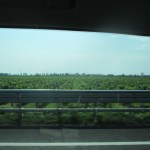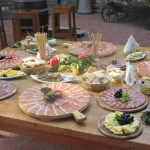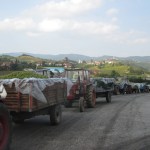 This is a review of a recent trip to the Goriška Brda area of Slovenia, and in particular the Vinska Klet Goriška Brda Winery, who hosted eight representatives from their U.S. distributors as well as myself. Slovenia was an unknown to me and almost everyone I talked to beforehand. Most
This is a review of a recent trip to the Goriška Brda area of Slovenia, and in particular the Vinska Klet Goriška Brda Winery, who hosted eight representatives from their U.S. distributors as well as myself. Slovenia was an unknown to me and almost everyone I talked to beforehand. Most
people just stared blankly when I said the name, and didn’t even know it was a country. I can assure you it is, and it is a beautiful country full of majestic scenery and friendly people. They also make outstanding wine, and you’ll hear a lot about that. Let’s see what happened.
The trip really started in chaos, as people coming from many different locations dealt with a major storm front coming through the east coast. We were supposed to meet in Philly, but that went out the window. I was lucky enough to get a break in the weather, arriving in Philadelphia in plenty of time for the next flight. Most had a much harder time of it.
From there it was 7 1/2 hours to Venice, which was uneventful. Due to the staggered arrivals caused by the weather four of the nine travelers were missing, and five of us headed off towards
Slovenia only to encounter a major accident on the autostrada and the need to back road it across the border. Fortunately our driver, Janez (who is the Export Manager at the winery), managed to successfully navigate the labyrinth of roundabouts, eventually getting us to our hotel for the first night, the Hotel Kozana. On the way we had seen the incredibly flat land around Venice continue for most of the trip, only turning into the hills of Brda right under the shadow of the Slovenian and Austrian Alps. The stretch of land where the best vineyards are located is really quite narrow. Here the slopes are terraced, and vineyards tuck into the hillsides in a way that reminds one of Piedmont or Tuscany. It is quite beautiful. There’s also not much of an international border here, as only a small sign marks your passage from Italy to Slovenia.
We did manage to get up to the top of the nearby hill as originally planned, and a tall
watchtower built at the summit. From its peak you could see all the way from the Alps to the sea. Some sparkling Rebula helped pass the time.
Then it was on to the Vinska Klet Goriška Brda Winery itself, and a repast of prosciutto, local salami and cheeses, along with more sparkling wine, this time the classic method produced Bagueri Brut, a traditional sparkler with ripe fruit, toast and clean flavors. This is really a quality sparkling wine.
A little downtime at the Hotel Kozana was spent admiring the view from the back deck, which looked over a small valley terraced with vines. A glass of red wine kept me in the right mood for this trip.
We took a drive into town for dinner, and spent three hours on a four course meal with accompanying wine parings. Dinner began with an English roast beef appetizer, thin slices served with Parmesan and accompanied by 2014 Avia Chardonnay and Pinot Grigio. We’ll review the wines separately in a later blog, but suffice it to say that the Avia line is one of the best values on the planet, especially the whites.
Course two, a pumpkin gnocchi with porcini mushrooms, was unfortunately not something I can talk about as I avoid the troublesome shroom whenever possible. It did have good flavor, as I nibbled on the gnocchi furthest from the mushrooms. The pumpkin was subtle. With this course the wine took a step up in quality, with the Colliano Cuvée White and Ribolla Gialla both shining. The white Cuvée was one of our favorite wines from the Newport Mansions Wine and Food Festival last year (read about that here), and the wine is really a complex and delicious white for surprisingly little money.
Course three was a simple but, I thought, very satisfying pork shank, marinated with Acacia
honey , cooked under vacuum and served with a root vegetable purée. Alright, it doesn’t sound simple but it presented that way, and it was quite tasty. I could have eaten two or three of them. With the pork the 2013 Avia Merlot and 2013 Colliano Cuvée Red were poured. The Merlot was very good, smooth and much better than the previous vintage I had tried last year. The Red Cuvée is really well done, showing red fruits, some tannin and nice balance. The Colliano line has a great quality to price point.
We finished with a refreshing yogurt and fruit mousse with fresh fruit sauce poured on top. Generally not my cup of tea, this was really good, and finished the meal well, cleaning the palate beautifully in bright fruit flavors. All in all this was a good meal, although it was a long one, especially at the end of an international travel day.
Day two was pretty special, starting with a quick breakfast and check out as we were switching hotels. Then came a short drive to the winery for some sparkling wine, this time the Colliano Rebula Peneca 2014. Now it was time to pick!
I try to pick grapes at least one morning every year now, and you can read about a few of them by clicking here or here. This was the best ever, as we arrived with a large group from both the U.S. and Bosnia, grabbed some
shears, downed a quick shot of Grappa and hit the rows of Sauvignonasse. We spent a few hours here, cleaning row after row and eventually filling a large trailer with ripe grapes. Such productivity deserved a reward, and it was in the form of wine as we toasted to our hard work, then took a
very short drive to the home of the vineyard owners, who provided amazing hospitality, not to mention a delicious lunch for forty hungry people. Sausage and mustard, a bowl of hearty vegetable, bean and pork soup and bread worked wonders for my appetite. Grappa flowed again, and it was homemade and delicious.
Today was all about wine though, and we went to the Vinska Klet Goriška Brda facility to watch the process currently underway, and were pretty amazed at what we saw. When you think of the word cooperative in this case you need to take it at its fullest meaning, as we pulled into the winery to see a line of tractors pulling large carts brimming with Sauvignonasse grapes from the different vineyards.
They waited their turn to pull into the crush pad, where the cart was turned sideways by some hydraulic machinery and the grapes cascaded down into a large screw driven crusher. Three of these operated side by side, keeping the flow of grapes going quite briskly, and a load of grapes falls from cart to crusher almost every three minutes. Each of these
loads had been weighed and analyzed for average sugar content, a factor in determining the actual price the farmer would be paid per kilo. One by one they went into the crusher, and we heard the estimate mentioned of 500,000 kilos processed that day. They know how to do this efficiently.
Consider again what is going in here. Four hundred and fifty grower/owners bring their various crops in according to a master
schedule developed by the wine makers and vineyard managers. The grapes are tracked through the season, especially as harvest approaches, through a sophisticated computer program. Certain sites are selected for various wines, and the cooperative works together with the owners to make it all fit. Control is the watchword here, and nothing is left to chance. That is crucial for the winery, as they are reaching into new markets and establishing their brand. Control leads to sustainable quality. Providing that at good prices leads to value, and that is what will propel them forward in the future.
The crushed grapes were fed by conveyor belt to the next step, and this varies depending on the grape and the line. Some wines will receive maceration time before pressing. Some are chilled down immediately. The winemakers are creative and ever experimenting to obtain the he best quality they possibly can. While the line of wines is somewhat extensive, it is even more impressive considering the different techniques and approaches they employ each year.
What started as a production tour turned into much more as we went into the cellars for
tastings and more exploring. One of my favorite things to do is barrel or cask tasting, and that is what we had a chance to do here. First we saw an open cask of a very special wine, Motnik, which Darinko, the lead oenologist, described as his “orange wine” but not really. He doesn’t like oxidized wines. While I do enjoy a glass of Madeira
occasionally, in general I am not a fan of oxidation either. Here Darinko ferments crushed Rebula grapes in casks that have been smoked with local herbs. They sit for a year, and afterwards he uses only the free run juice, this is not pressed. We had a chance to try the finished product later in the trip and it is a very cerebral wine, with a decidedly herbal note. While not something I would drink normally it is obviously very well made and many people will love it.
Other opportunities presented themselves, and we next tried some partially fermented Pinot
Grigio. After four to five days of fermentation the wine was under halfway through its conversion of sugar to alcohol. Checking in at 5-6% the wine will eventually finish somewhere around 12-13% alcohol content. We all agreed this was amazingly delicious, and terms like grapefruit, kiwi and white peach were discussed. It really seemed like they should chill this and sterile filter the yeast right now, because you could drink this all the time and it would be insane with some vodka thrown in. I would buy gallons. Then I would buy more.
One very cool part of the tour was a glance inside their library, a multi-chambered, old looking area filled with stacked bottles everywhere. They go back to the beginning of the winery, and the cobwebs just add to the ambiance. It looks every bit like an ancient cellar.
 After wine it was of course time for dinner, and this night we drove to the Venko Casino for a four course meal with wine pairings from the Vinska Klet Goriška Brda lines. We started with sparkling wine, which seems to be how we start everything unless someone has a bottle of grappa handy. The first course was prosciutto with fresh fig and mozzarella. The figs
After wine it was of course time for dinner, and this night we drove to the Venko Casino for a four course meal with wine pairings from the Vinska Klet Goriška Brda lines. We started with sparkling wine, which seems to be how we start everything unless someone has a bottle of grappa handy. The first course was prosciutto with fresh fig and mozzarella. The figs
here are amazing, I have to say. Wines included the Quercus Rebula, a quality white with peach, citrus and a long finish. If you like a white with complexity, some texture and really bright flavors this is a very viable option. I have become a big fan of Rebula, or Ribolla Gialla, bubbles or not.
Course two was a beef brisket ravioli with good flavor. The Bagueri Chardonnay paired with it worked, however I would probably have served this with a red. Bordeaux popped into my mind, and others suggest a Barbera d’Alba. They all would have worked. The Bagueri is a big, rich Chardonnay with great fruit.
The third course was Venison, and somewhat overdone. Unfortunate, as the flavors were good. The Avia Cabernet Sauvignon and Bagueri Merlot accompanied the venison. The entire Avia line is exceptionally good value. The Baqueri line is their best full line of wines. These were however, served too cold as it seemed the staff had chilled them, and it took a while for them to warm up. The Merlot is quite dry, and one of our group suggested it might be “the driest wine in the world”. Not so, but we did have a few good laughs about it over the next several days. We’ll skip the grape strudel, as that didn’t really work. Overall this was the only somewhat disappointing meal we encountered over the trip. And that is the only slightly negative comment I can muster for four days of incredible hospitality.
I would be remiss in not mentioning the second hotel, where we stayed for the remainder of the trip. The Hotel San Martin sits on the edge of the village of Šmartno, a short drive from the winery. Perched on a ridge it has stunning valley views from its back rooms, restaurant and outside areas. Across the street is a scenic overlook that commands views of the opposite valley. Rooms are very clean and comfortable, as is the entire establishment. We spent quite a few hours just lounging at the hotel, and the owners create a very comfortable environment. When I return with Cheri, this is where we’ll stay in Goriška Brda. Check them out if you are heading that way. Here’s their website: http://en.sanmartin.si/about-us/. There are several suites available also, and the prices are great.
In Part 2 I’ll cover the last two days of the trip, with more about the history of this land and a peek at the Capital of Ljubljana. Finally, since this was really all about the wine, I’ll cover the wines available in the U.S. and talk about the values many of these represent.
A votre santé!


















[…] of the country as well as the quality of the wines. You can read more about the trip by clicking here and here. There was wine, there was food, and there were new friends made. It was pretty […]